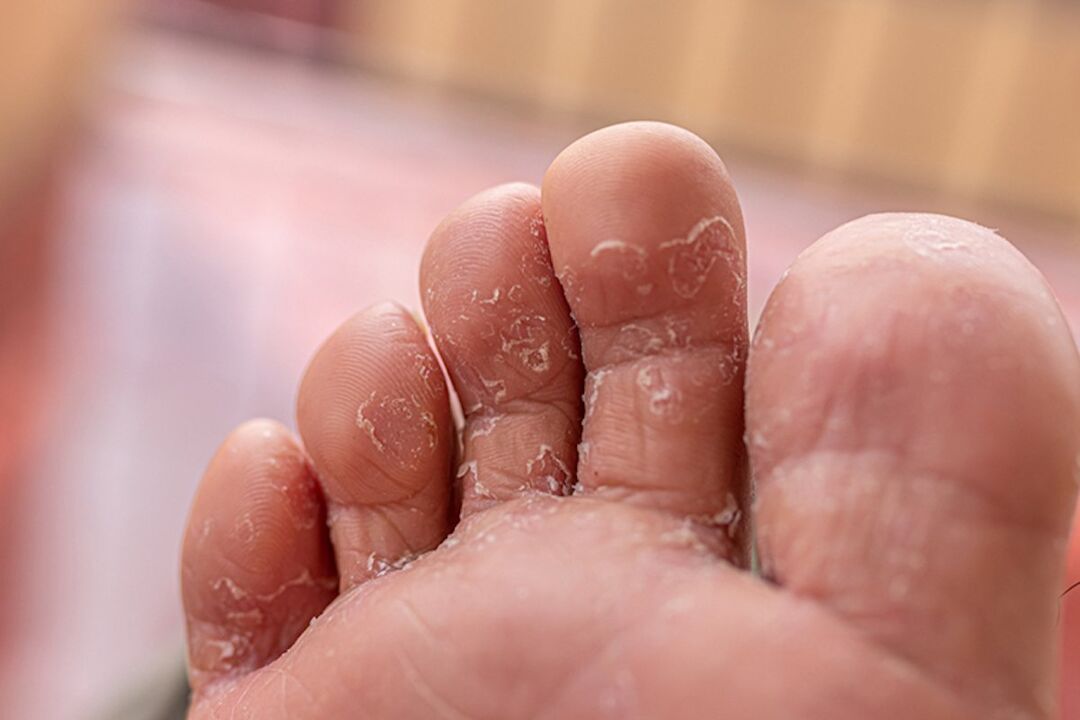
Interdigital mycosis is a fungal infection of the skin in the spaces between the fingers, caused by opportunistic organisms and anthropophilic fungi.
Causes of mycoses
The cause of any mycosis is contact with an infected person, wearing his shoes or sharing personal hygiene products with him. The probability of infection increases in people with reduced immunity - due to chronic diseases, taking certain drugs or vitamin deficiency.
Patients at risk:
- disorders in the work of the endocrine system;
- diabetes mellitus and its complications (especially diabetic foot);
- allergic dermatitis;
- varicose veins;
- obesity;
- increased sweating;
- immune disorders;
- hormonal disorders;
- metabolic disorders in the body, etc.
After a cutting pedicure, the skin of the feet is very sensitive to fungi. And wearing shoes that are too tight can significantly aggravate the condition.
Symptoms
In the initial stages, interdigital mycosis is manifested by a slight itching of the skin between the toes. Later, skin peeling, redness and the appearance of cracks are added to this symptom.
If you do not take action and consult a specialist, the problem will get worse - burning, diaper rash, swelling of the area between the fingers will appear. Small blisters that tend to coalesce may begin to form in the interdigital folds. When such bubbles burst, weeping erosions remain in place and become covered with crusts. This condition is dangerous due to infection - the wounds may fester.
It should be noted that with a long course of interdigital mycosis, the forms of the disease can become one another or develop in parallel.
Interdigital mycosis can also occur in an erased form - in this case, the patient periodically experiences unpleasant symptoms of the disease (usually during and after water procedures and with excessive sweating of the feet).
Diagnosis of fungus between the toes
Experience shows that a fungal infection is diagnosed in about every third case of skin damage between the toes.
When prescribing treatment for mycosis, the podiatrist takes into account many factors: the presence or absence of accompanying pathologies in the patient, the clinical picture, form and degree of the disease.
The diagnosis of a specific pathogen is the key to effective treatment and successful recovery. To determine which fungus needs to be treated, the podiatrist may order laboratory tests and a bacterial culture.
How to treat interdigital fungus?
Complex therapy is carried out for interdigital mycoses. This includes:
- local antifungal drugs (creams, lotions, ointments, etc. );
- It is also possible to take oral antifungal agents.
The course of treatment is determined individually for the patient. Traditional medicine (compresses, baths, lotions from medicinal plants, etc. ) can be used as auxiliary methods, but only after consulting a specialist.
If mycosis develops against the background of internal diseases, local therapy is combined with the treatment of the main pathology.
Possible contraindications and complications
Interdigital mycosis requires referral to a specialist and complex therapy. If not treated in time, it quickly spreads to the entire foot and affects the nails.
In addition, in patients with mycosis, the sensitivity of the body to viral diseases increases, the risk of bacterial infection and allergic reactions increases.
It is important to strictly follow the recommendations of the podiatrist and complete the course of treatment. Pathogens can be resistant to the drugs used, and together with repeated infections, this makes it much more difficult to get rid of the infection - even if there are positive dynamics, the course of treatment cannot be interrupted.
Tips and recommendations from a podiatrist
To prevent fungal infection, it is necessary to strictly observe the rules of personal hygiene - first of all, this applies to personal hygiene items and shoes.
- Do not wear other people's shoes and use only individual bath towels.
- Do not walk barefoot in the bath, sauna or swimming pool - as it is always hot and high humidity, it is an ideal environment for the development of fungi.
- If you experience excessive sweating of the skin of your feet, you should consult a podiatrist about the use of anti-hyperhidrosis drugs.
- Do not wear shoes that are too tight and avoid synthetic socks and stockings that do not allow the skin to "breathe".
To care for the skin of the feet, podiatrists recommend giving preference to hardware methods - a cut pedicure is considered outdated and dangerous today. It is very difficult to control how cutting pedicure tools are processed - the risk of infection increases significantly. The possibility of infection with a hardware pedicure is excluded.

























